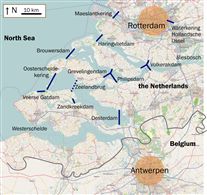Deltawerken_na.jpg
Delta Works - Click 'Details' for more information
Delta Works:
The Delta Works is a series of construction projects in the southwest of the Netherlands to protect a large area of land around the Rhine-Meuse-Scheldt delta from the sea. The works consist of dams, sluices, locks, dikes, levees, and storm surge barriers. The aim of the dams, sluices, and storm surge barriers was to shorten the Dutch coastline, thus reducing the number of dikes that had to be raised.
Along with the Zuiderzee Works, they have been declared one of the Seven Wonders of the Modern World by the American Society of Civil Engineers.
History:
The estuaries of the rivers Rhine, Meuse and Scheldt have been subject to flooding over the centuries. After building the Afsluitdijk, the Dutch started studying the damming of the Rhine-Meuse Delta. Plans were developed for shortening the coastline and turning the delta into a group of freshwater lakes. By shortening the coastline fewer dikes would have to be reinforced.
Due to indecision and the Second World War, little action was taken. In 1950 two small estuary mouths, the Brielse Gat near Brielle and the Botlek near Vlaardingen were dammed. After the North Sea flood of 1953, a commission was installed which had to come up with a plan to research the causes and seek measures to prevent such disasters in future. They revised some of the old plans and came up with the so called "Deltaplan".
The plan consisted of blocking the estuary mouths of the Oosterschelde, the Haringvliet and the Grevelingen. This reduced the length of the dikes exposed to the sea by approximately 400 miles (640 km). The mouths of the Nieuwe Waterweg and the Westerschelde were to remain open because of the shipping routes to the ports of Rotterdam and Antwerp. The dikes along these waterways were to be heightened and strengthened. The works would be combined with road and waterway infrastructure to stimulate the economy of the province of Zeeland and improve the connection between the port of Rotterdam and Antwerp.
Delta law and Conceptual framework:
An important part of this project was fundamental research to help solve the flooding problem. Instead of analysing past floods and building protection sufficient to deal with those, the Delta Works commission pioneered a conceptual framework to use as norm for investment in flood defences.
The framework is called the 'Delta norm' and works as follows:
Major areas to be protected from flooding are identified. These are called "dike ring areas" because they are protected by a ring of primary sea defences.
The cost of flooding is assessed using a statistical model involving damage to property, lost production and a given amount per human life lost.
For the purpose of this model a human life is valued at €2.2 million (2008 data).
The chances of a significant flood within the given area are calculated. This is done using data from a purpose-built flood simulation lab as well as empirical statistical data regarding water wave properties and distribution. Storm behaviour and spring tide distribution are also taken into account.
The most important "dike ring area" is the South Holland coast region. It is home to four million people, most of whom live below normal sea level. The loss of human life in a catastrophic flood here can be very large because there is very little warning time with North Sea storms, and so comprehensive evacuation is not a realistic option for the Holland coastal region.
The commission initially set the acceptable risk for complete failure of every "dike ring" in the country at 1 in 125,000 years. However the cost of building this level of protection was deemed too high, so the acceptable risk was set according to region as follows:
North and South Holland (excluding Wieringermeer): 1 per 10,000 years
Other areas at risk from sea flooding: 1 per 4,000 years
Transition areas between high land and low land: 1 per 2,000 years
River flooding causes less damage than salt water flooding so areas at risk from river flooding have a higher acceptable risk. River flooding also has a longer warning time, making for a lower estimated death toll.
South Holland at risk from river flooding: 1 per 1,250 years
Other areas at risk from river flooding: 1 per 250 years.
These acceptable risks were enshrined in the Delta law, requiring the government to keep risks of catastrophic flooding within these limits and to upgrade defences should new insights into risks require this. These limits are also incorporated into the new Water Law, effective from 22 December 2009.
The Delta Project (of which the Delta Works are a part) has been designed with these guidelines in mind. All other primary defences have been upgraded to meet the norm.
New data elevating the risk assessment on expected sea level rise due to global warming has brought ten 'weak points' to the fore. These are currently being upgraded to meet the future demands. This work is expected to be completed in 2015. For rivers an upgrade is underway, which is expected to be finished in 2017.
